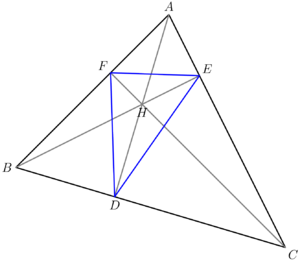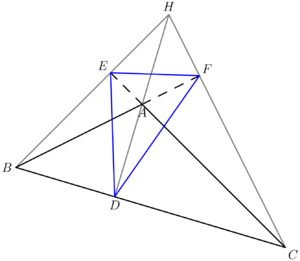Difference between revisions of "Orthic triangle"
(→Incenter of the orthic triangle) |
m (→Incenter of the orthic triangle) |
||
| (4 intermediate revisions by one other user not shown) | |||
| Line 18: | Line 18: | ||
If <math>\triangle ABC</math> is acute, then the incenter of the orthic triangle of <math>\triangle ABC</math> is the orthocenter <math>H</math>. | If <math>\triangle ABC</math> is acute, then the incenter of the orthic triangle of <math>\triangle ABC</math> is the orthocenter <math>H</math>. | ||
| − | ''Proof'': Let <math>\theta = \angle EAH</math>. Since <math>\angle ADC = 90^\circ</math>, we have that <math>\theta = 90^\circ - C</math>. The quadrilateral <math>EAFH</math> is cyclic and, in fact <math>E</math> and <math>F</math> lie on the circle with diameter <math>AH</math>. Since <math>EH</math> subtends <math>\theta</math> as well as <math>\angle EFH</math> on this circle, so <math>\angle EFH = \theta = 90^\circ - C</math>. The same argument (with <math> | + | ''Proof'': Let <math>\theta = \angle EAH</math>. Since <math>\angle ADC = 90^\circ</math>, we have that <math>\theta = 90^\circ - \angle C</math>. The quadrilateral <math>EAFH</math> is cyclic and, in fact <math>E</math> and <math>F</math> lie on the circle with diameter <math>AH</math>. Since <math>EH</math> subtends <math>\theta</math> as well as <math>\angle EFH</math> on this circle, so <math>\angle EFH = \theta = 90^\circ - \angle C</math>. The same argument (with <math>FBDH</math> instead of <math>EAFH</math>) shows that <math>\angle DFH = 90^\circ - \angle C</math>. Hence <math>\angle EFH = \angle DFH</math>, i.e. the line <math>HF</math> bisects <math>\angle EFD</math>. By the same reasoning <math>HD</math> bisects <math>\angle EDF</math> and <math>HE</math> bisects <math>\angle FED</math>. |
| + | <math>\square</math> | ||
If <math>\triangle ABC</math> is obtuse, then the incenter of the orthic triangle of <math>\triangle ABC</math> is the obtuse vertex. | If <math>\triangle ABC</math> is obtuse, then the incenter of the orthic triangle of <math>\triangle ABC</math> is the obtuse vertex. | ||
| Line 48: | Line 49: | ||
== Problems == | == Problems == | ||
| + | * In acute triangle <math>ABC</math> points <math>P</math> and <math>Q</math> are the feet of the perpendiculars from <math>C</math> to <math>\overline{AB}</math> and from <math>B</math> to <math>\overline{AC}</math>, respectively. Line <math>PQ</math> intersects the circumcircle of <math>\triangle ABC</math> in two distinct points, <math>X</math> and <math>Y</math>. Suppose <math>XP=10</math>, <math>PQ=25</math>, and <math>QY=15</math>. Compute the product <math>AB\cdot AC</math>. (AIME II, 2019, 15) | ||
===Olympiad=== | ===Olympiad=== | ||
* Let <math>\triangle ABC</math> be an acute triangle with <math>D</math>, <math>E</math>, <math>F</math> the feet of the altitudes lying on <math>\overline{BC}</math>, <math>\overline{CA}</math>, and <math>\overline{AB}</math> respectively. One of the intersection points of the line <math>\overline{EF}</math> and the circumcircle is <math>P</math>. The lines <math>\overline{BP}</math> and <math>\overline{DF}</math> meet at point <math>Q</math>. Prove that <math>|AP| = |AQ|</math>. (IMO Shortlist 2010 G1) | * Let <math>\triangle ABC</math> be an acute triangle with <math>D</math>, <math>E</math>, <math>F</math> the feet of the altitudes lying on <math>\overline{BC}</math>, <math>\overline{CA}</math>, and <math>\overline{AB}</math> respectively. One of the intersection points of the line <math>\overline{EF}</math> and the circumcircle is <math>P</math>. The lines <math>\overline{BP}</math> and <math>\overline{DF}</math> meet at point <math>Q</math>. Prove that <math>|AP| = |AQ|</math>. (IMO Shortlist 2010 G1) | ||
Latest revision as of 08:39, 10 July 2024
In geometry, given any ![]() , let
, let ![]() ,
, ![]() , and
, and ![]() denote the feet of the altitudes from
denote the feet of the altitudes from ![]() ,
, ![]() , and
, and ![]() , respectively. Then,
, respectively. Then, ![]() is called the orthic triangle of
is called the orthic triangle of ![]() .
.
The orthic triangle does not exist if ![]() is right. The two cases of when
is right. The two cases of when ![]() is either acute or obtuse each carry different characteristics and must be handled separately.
is either acute or obtuse each carry different characteristics and must be handled separately.
Orthic triangles are not unique to their mother triangle; one acute and one to three obtuse triangles are guaranteed to have the same orthic triangle. To see this, take an acute triangle and swap its orthocenter and any vertex to get an obtuse triangle. It is easy to verify that this placement of the orthocenter is correct and that the orthic triangle will remain the same as before the swapping, as seen in the diagrams to the right.
Contents
[hide]Cyclic quadrilaterals
In both the acute and obtuse case, quadrilaterals ![]() ,
, ![]() ,
, ![]() ,
, ![]() ,
, ![]() , and
, and ![]() are cyclic. These cyclic quadrilaterals make frequent appearances in olympiad geometry and are the most crucial section of this article.
are cyclic. These cyclic quadrilaterals make frequent appearances in olympiad geometry and are the most crucial section of this article.
Proof: we will be using directed angles, denoted by ![]() instead of the conventional
instead of the conventional ![]() . We know that
. We know that ![]() and thus
and thus ![]() is cyclic. In addition,
is cyclic. In addition, ![]() so
so ![]() is also cyclic. It follows that the other cyclic quadrilaterals are also cyclic.
is also cyclic. It follows that the other cyclic quadrilaterals are also cyclic.
![]()
Connection with incenters and excenters
Incenter of the orthic triangle
If ![]() is acute, then the incenter of the orthic triangle of
is acute, then the incenter of the orthic triangle of ![]() is the orthocenter
is the orthocenter ![]() .
.
Proof: Let ![]() . Since
. Since ![]() , we have that
, we have that ![]() . The quadrilateral
. The quadrilateral ![]() is cyclic and, in fact
is cyclic and, in fact ![]() and
and ![]() lie on the circle with diameter
lie on the circle with diameter ![]() . Since
. Since ![]() subtends
subtends ![]() as well as
as well as ![]() on this circle, so
on this circle, so ![]() . The same argument (with
. The same argument (with ![]() instead of
instead of ![]() ) shows that
) shows that ![]() . Hence
. Hence ![]() , i.e. the line
, i.e. the line ![]() bisects
bisects ![]() . By the same reasoning
. By the same reasoning ![]() bisects
bisects ![]() and
and ![]() bisects
bisects ![]() .
.
![]()
If ![]() is obtuse, then the incenter of the orthic triangle of
is obtuse, then the incenter of the orthic triangle of ![]() is the obtuse vertex.
is the obtuse vertex.
Excenters of the orthic triangle
For any acute ![]() and any
and any ![]() ,
, ![]() is the orthic triangle of
is the orthic triangle of ![]() if and only if
if and only if ![]() ,
, ![]() , and
, and ![]() are the excenters of
are the excenters of ![]() .
.
Proof: First, we show that the orthic triangle leads to the excenters. Let ![]() ,
, ![]() , and
, and ![]() be on
be on ![]() ,
, ![]() , and
, and ![]() , respectively. Because
, respectively. Because ![]() is cyclic,
is cyclic, ![]() . Likewise,
. Likewise, ![]() as well. Then because
as well. Then because ![]() ,
, ![]() and so
and so ![]() .
.
Thus, the exterior angle of ![]() is
is ![]() . But
. But ![]() , so
, so ![]() bisects the exterior angle of
bisects the exterior angle of ![]() . Similarly,
. Similarly, ![]() and
and ![]() bisect the exterior angles of
bisect the exterior angles of ![]() and
and ![]() respectively. Thus, the intersections of
respectively. Thus, the intersections of ![]() ,
, ![]() , and
, and ![]() (namely
(namely ![]() ,
, ![]() , and
, and ![]() ) are the excenters of
) are the excenters of ![]() , and we are halfway finished.
, and we are halfway finished.
Next, we show that the excenters lead to the orthic triangle. Let ![]() ,
, ![]() , and
, and ![]() be the
be the ![]() -excenter,
-excenter, ![]() -excenter, and
-excenter, and ![]() -excenter of
-excenter of ![]() , and let
, and let ![]() be the incenter of
be the incenter of ![]() .
. ![]() is equidistant from
is equidistant from ![]() and
and ![]() , so
, so ![]() is on
is on ![]() ; as a result,
; as a result, ![]() is an internal angle bisector of
is an internal angle bisector of ![]() .
.
We know that ![]() and because
and because ![]() is an
is an ![]() -excenter of
-excenter of ![]() ,
, ![]() . Thus,
. Thus, ![]() , and because
, and because ![]() is on
is on ![]() ,
, ![]() is the foot of the altitude from
is the foot of the altitude from ![]() of
of ![]() . Similarly,
. Similarly, ![]() and
and ![]() are feet of the altitudes from
are feet of the altitudes from ![]() and
and ![]() , respectively. Then
, respectively. Then ![]() is the orthic triangle of
is the orthic triangle of ![]() , and we are done.
, and we are done.
![]()
This lemma makes frequent appearances in olympiad geometry. Problems written in either excenters or the orthic triangle can often be solved by shifting perspective to the other, via the medium of this lemma. Also, note the converse works as well.
In the obtuse case, the two vertices with acute angles and the orthocenter of ![]() are the excenters.
are the excenters.
Relationship with the incenter/excenter lemma
With this knowledge in mind, we can transfer results about the incenter and excenters to the orthic triangle. In particular, the incenter/excenter lemma can be translated into the language of the orthic triangle. It tells that all six cyclic quadrilaterals of the orthic triangle have a circumcenter on the nine-point circle of ![]() .
.
In the case where ![]() is acute, quadrilaterals
is acute, quadrilaterals ![]() ,
, ![]() , and
, and ![]() follow immediately from the lemma. Actually, because
follow immediately from the lemma. Actually, because ![]() , the circumcenter of
, the circumcenter of ![]() is the midpoint of
is the midpoint of ![]() and
and ![]() , called an Euler point. It follows that the circumcenters of
, called an Euler point. It follows that the circumcenters of ![]() and
and ![]() are the other two Euler points.
are the other two Euler points.
As for ![]() ,
, ![]() , and
, and ![]() , via the inscribed angle theorem, their circumcenters are the midpoints of the side lengths of
, via the inscribed angle theorem, their circumcenters are the midpoints of the side lengths of ![]() , which we know to be on the nine-point circle.
, which we know to be on the nine-point circle.
Identical reasoning follows that in the obtuse case, the six cyclic quadrilaterals still have circumcenters on the nine-point circle.
Problems
- In acute triangle
 points
points  and
and  are the feet of the perpendiculars from
are the feet of the perpendiculars from  to
to  and from
and from  to
to  , respectively. Line
, respectively. Line  intersects the circumcircle of
intersects the circumcircle of  in two distinct points,
in two distinct points,  and
and  . Suppose
. Suppose  ,
,  , and
, and  . Compute the product
. Compute the product  . (AIME II, 2019, 15)
. (AIME II, 2019, 15)
Olympiad
- Let
 be an acute triangle with
be an acute triangle with  ,
,  ,
,  the feet of the altitudes lying on
the feet of the altitudes lying on  ,
,  , and
, and  respectively. One of the intersection points of the line
respectively. One of the intersection points of the line  and the circumcircle is
and the circumcircle is  . The lines
. The lines  and
and  meet at point
meet at point  . Prove that
. Prove that  . (IMO Shortlist 2010 G1)
. (IMO Shortlist 2010 G1)











